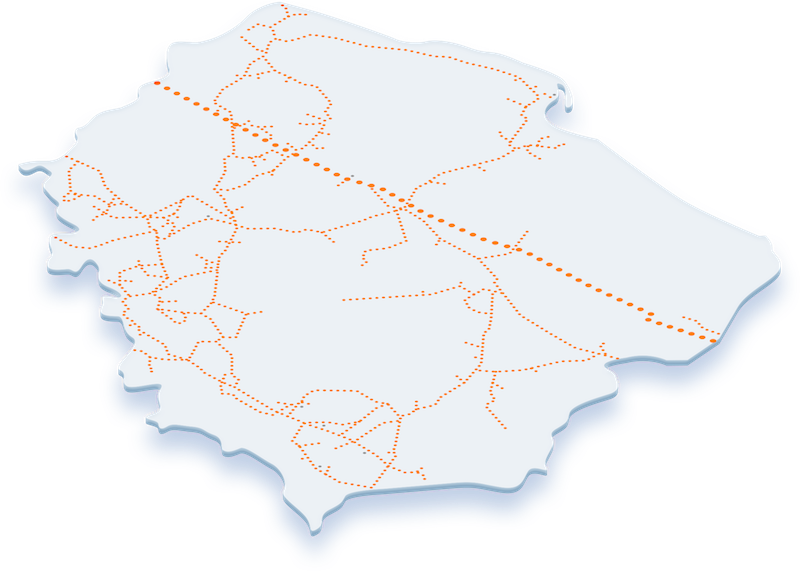Gromadź piękne chwile. My zajmiemy się gazem.
-
12.04.2024
Informacja o zmianie charakterystyk zatłaczania i odbioru dla GIM Kawerna od początku sezonu 2024/2025
Gas Storage Poland sp. z o. o. z siedzibą w Dębogórzu pełniąca →
-
05.04.2024
Zaproszenie do udziału w badaniu zapotrzebowania na usługi magazynowania paliwa gazowego
Gas Storage Poland sp. z o. o. z siedzibą w Dębogórzu („GSP") →
-
26.03.2024
Informacja dotycząca parametrów Zdolności Magazynowych na Warunkach Ciągłych udostępnionych zgodnie z ogłoszeniem z dnia 29.01.2024 r. w Instalacji Magazynowej PMG Wierzchowice, w GIM Kawerna oraz w GIM Sanok oraz możliwości świadczenia do 30.09.2024 r. części Zdolności Magazynowych na Warunkach Przerywanych jak Zdolności Magazynowych na Warunkach Ciągłych.
Gas Storage Poland sp. z o. o. z siedzibą w Dębogórzu, wyznaczona →
-
29.01.2024
Informacja o udostępnieniu Zdolności Magazynowych w Instalacji Magazynowej PMG Wierzchowice, w GIM Kawerna oraz w GIM Sanok
Gas Storage Poland sp. z o. o. z siedzibą w Dębogórzu, wyznaczona →
Lokalizacje PMG
GIM Kawerna
Stan napełnienia instalacji magazynowych na początek doby
stan napełnienia instalacji magazynowych na początek doby
ilość gazu odebranego
stan napełnienia instalacji magazynowych na koniec doby
ilość gazu zatłoczonego
GIM Kawerna
Stan napełnienia instalacji magazynowych na początek doby
stan napełnienia instalacji magazynowych na początek doby
ilość gazu odebranego
stan napełnienia instalacji magazynowych na koniec doby
ilość gazu zatłoczonego
IM Wierzchowice
Stan napełnienia instalacji magazynowych na początek doby
stan napełnienia instalacji magazynowych na początek doby
ilość gazu odebranego
stan napełnienia instalacji magazynowych na koniec doby
ilość gazu zatłoczonego
GIM Sanok
Stan napełnienia instalacji magazynowych na początek doby
stan napełnienia instalacji magazynowych na początek doby
ilość gazu odebranego
stan napełnienia instalacji magazynowych na koniec doby
ilość gazu zatłoczonego
GIM Sanok
Stan napełnienia instalacji magazynowych na początek doby
stan napełnienia instalacji magazynowych na początek doby
ilość gazu odebranego
stan napełnienia instalacji magazynowych na koniec doby
ilość gazu zatłoczonego
GIM Sanok
Stan napełnienia instalacji magazynowych na początek doby
stan napełnienia instalacji magazynowych na początek doby
ilość gazu odebranego
stan napełnienia instalacji magazynowych na koniec doby
ilość gazu zatłoczonego
GIM Sanok
Stan napełnienia instalacji magazynowych na początek doby
stan napełnienia instalacji magazynowych na początek doby
ilość gazu odebranego
stan napełnienia instalacji magazynowych na koniec doby
ilość gazu zatłoczonego
Stan napełnienia instalacji magazynowych
Dane na koniec doby gazowej 26.04
(stan na godzinę 6:00)*
*) dane te są równoważne z danymi na początek następnej doby gazowej
Gromadź piękne chwile. My zajmiemy się gazem.
Stan napełnienia instalacji magazynowych
Dane na koniec doby gazowej 26.04
(stan na godzinę 6:00)*
*) dane te są równoważne z danymi na początek następnej doby gazowej
Gromadź piękne chwile. My zajmiemy się gazem.
-
12.04.2024
Informacja o zmianie charakterystyk zatłaczania i odbioru dla GIM Kawerna od początku sezonu 2024/2025
Gas Storage Poland sp. z o. o. z siedzibą w Dębogórzu pełniąca →
-
05.04.2024
Zaproszenie do udziału w badaniu zapotrzebowania na usługi magazynowania paliwa gazowego
Gas Storage Poland sp. z o. o. z siedzibą w Dębogórzu („GSP") →
-
26.03.2024
Informacja dotycząca parametrów Zdolności Magazynowych na Warunkach Ciągłych udostępnionych zgodnie z ogłoszeniem z dnia 29.01.2024 r. w Instalacji Magazynowej PMG Wierzchowice, w GIM Kawerna oraz w GIM Sanok oraz możliwości świadczenia do 30.09.2024 r. części Zdolności Magazynowych na Warunkach Przerywanych jak Zdolności Magazynowych na Warunkach Ciągłych.
Gas Storage Poland sp. z o. o. z siedzibą w Dębogórzu, wyznaczona →
-
29.01.2024
Informacja o udostępnieniu Zdolności Magazynowych w Instalacji Magazynowej PMG Wierzchowice, w GIM Kawerna oraz w GIM Sanok
Gas Storage Poland sp. z o. o. z siedzibą w Dębogórzu, wyznaczona →
Gromadź piękne chwile. My zajmiemy się gazem.
Gromadź piękne chwile. My zajmiemy się gazem.
Lokalizacje PMG
GIM Kawerna
Stan napełnienia instalacji magazynowych na początek doby
stan napełnienia instalacji magazynowych na początek doby
stan napełnienia instalacji magazynowych na koniec doby
ilość gazu odebranego
ilość gazu zatłoczonego
GIM Kawerna
Stan napełnienia instalacji magazynowych na początek doby
stan napełnienia instalacji magazynowych na początek doby
stan napełnienia instalacji magazynowych na koniec doby
ilość gazu odebranego
ilość gazu zatłoczonego
IM Wierzchowice
Stan napełnienia instalacji magazynowych na początek doby
stan napełnienia instalacji magazynowych na początek doby
stan napełnienia instalacji magazynowych na koniec doby
ilość gazu odebranego
ilość gazu zatłoczonego
GIM Sanok
Stan napełnienia instalacji magazynowych na początek doby
stan napełnienia instalacji magazynowych na początek doby
stan napełnienia instalacji magazynowych na koniec doby
ilość gazu odebranego
ilość gazu zatłoczonego
GIM Sanok
Stan napełnienia instalacji magazynowych na początek doby
stan napełnienia instalacji magazynowych na początek doby
stan napełnienia instalacji magazynowych na koniec doby
ilość gazu odebranego
ilość gazu zatłoczonego
GIM Sanok
Stan napełnienia instalacji magazynowych na początek doby
stan napełnienia instalacji magazynowych na początek doby
stan napełnienia instalacji magazynowych na koniec doby
ilość gazu odebranego
ilość gazu zatłoczonego
GIM Sanok
Stan napełnienia instalacji magazynowych na początek doby
stan napełnienia instalacji magazynowych na początek doby
stan napełnienia instalacji magazynowych na koniec doby
ilość gazu odebranego
ilość gazu zatłoczonego



